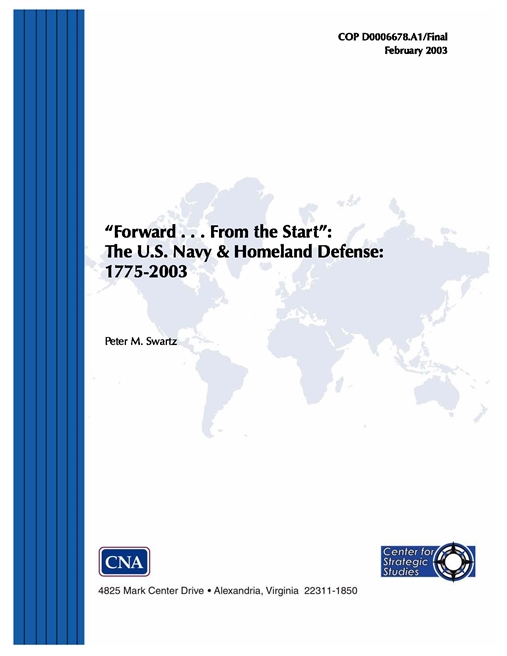On September 11, 2001, terrorists hijacked four loaded passenger aircraft and slammed three into the World Trade Center and the Pentagon. (A similar attack on a target in Washington, DC, was foiled by the brave and selfless actions of the passengers in the fourth aircraft). The American people and their leaders and representatives demanded immediate protection, including close-in naval harbor and offshore homeland defense.
Capturing the national mood, Congressman W.J."Billy" Tauzin (R-LA) suggested that a "Navy cruiser might be needed in the Potomac River to protect the airspace." The response of U.S. Navy forces was immediate, substantial, and in some ways unprecedented, both at home and far forward. Carriers and cruisers rapidly deployed off American cities on each coast. A hospital ship quickly deployed to New York, where a fast sealift ship had already been pressed into immediate service. A Naval Reserve strike fighter squadron provided air cover over the President’s ranch in Crawford, Texas. Navy E-2 Hawkeyes took to the air to provide surveillance coverage. Other Navy and Naval Reserve units responded as well.
Meanwhile, the Coast Guard had sprung to action at home as well, as massively as was possible for that much smaller service. Much of its force structure on the East Coast sped for New York, where the Coast Guard provided security for the evacuation of a million people from the lower Manhattan waterfront. Cutters took up stations at all the nation’s ports, and began to enforce new control measures, including keeping civilian vessels away from Navy ships. The Chief of Naval Operations poured more watch standers into the National Maritime Intelligence Center, and told the Commandant that he’d help in any way he could. Naval base security was beefed up, and later thirteen small Navymanned patrol coastal (PC) warships chopped to Coast Guard operational control.
And then it was over at home for most of the Navy. True, lots of small changes were made and continued to be made, largely by dint of hard work by officers, sailors and civilians alike: Base security stayed heightened, new barriers appeared at gates and in the water; Navy master-at-arms forces expanded; and a couple of innovative joint harbor defense command posts were set up. The PCs stayed with the Coast Guard, and some in-port warships with air defense capabilities were given collateral assignments. Some new research and development projects were launched. Navy and joint staffs ground out plans, Navy intelligence efforts in Maritime Domain Awareness vastly increased, and a few imaginative force protection games and fleet exercises were and are being run. And the Navy's new Fleet Forces Command became a component of the even newer joint Northern Command, charged with homeland defense missions.
But no major changes in naval programs or force dispositions ensued. The carriers left their stations off America's harbors as quickly as they had taken them up. No new, dedicated Navy "Homeland Defense Squadrons" were created. No existing Maritime Defense Zones were activated. No in-strength sustained coastal patrols were inaugurated. No at-sea Navy barriers were set up off America's shores. No new Navy homeland defense ship types appeared in the Navy budget. Congressman Tauzin's cruiser never did sail up the Potomac.
Far forward in the Indian Ocean and elsewhere, however, it was a very different story. There the response—and counter-attack—was not only immense and immediate, but also sustained. Carriers raced into position off Pakistan, one carrying Special Operations Forces. So too did Amphibious Ready Groups and their Marines, cruise missilecapable attack submarines and surface combatants, and maritime patrol aircraft. The Navy contribution to Operation Enduring Freedom in Afghanistan was quick, in strength, and most important—like the operation’s name—enduring. Smaller forward operations were mounted in the Mediterranean and the Straits of Malacca. A little over a year later, the Navy deployed even larger forces far forward, this time to deal with Iraq (even taking with them some of the PCs and part of the Coast Guard).
Download reportAPPROVED FOR PUBLIC RELEASE; DISTRIBUTION UNLIMITED
Details
- Pages: 22
- Document Number: COP D0006678.A1
- Publication Date: 2/3/2003
